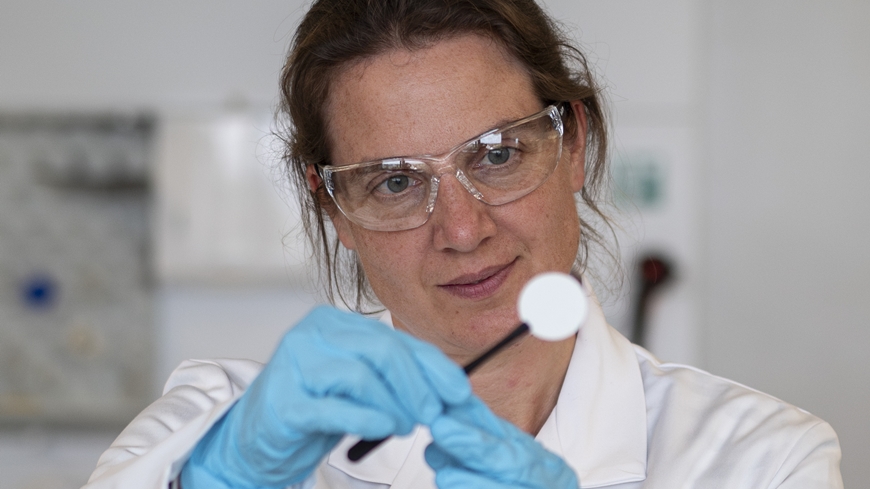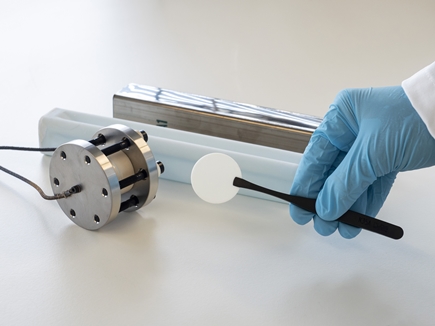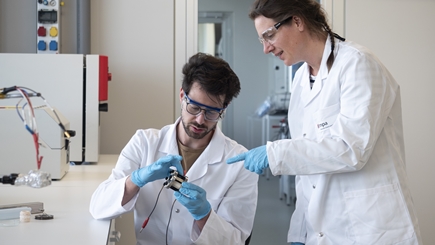Salt batteries
The fireproof battery
Originally developed for electric cars, nowadays they supply mobile phone antennas with electricity, and tomorrow perhaps entire districts: The salt battery is a safe and long-lasting battery technology with huge potential. Empa researchers are collaborating with an industrial partner to further develop these special batteries.

In 1997, the Mercedes-Benz A-Class famously tipped out of a bend during the elk test. One of the causes of the infamous incident: The car was originally designed to be electric. Switching to a combustion engine eliminated the heavy battery, resulting in the center of gravity shifting too far upwards.
The battery that should have been installed in the A-Class was a so-called salt battery. In contrast to most other batteries, in which the cathode and anode are immersed in a shared pool of liquid electrolyte, the electrolyte in a salt battery is a solid, namely a ceramic ion conductor based on sodium aluminum oxide. The solid electrolyte is non-flammable and allows the anode and cathode to be separated, which increases the service life of the battery. The cathode of a salt battery is based on granules of common salt and nickel powder; the sodium metal anode is only formed during charging.
For electromobility, this battery technology has not proven to be the best solution. Today's electric cars run on lithium-ion batteries, which are lighter and quicker to charge. However, for other applications, salt batteries are superior to their lithium-ion competitors. For this reason, they are the subject of ongoing research – at Empa, among others.
Safe and durable

The research collaboration began in 2016 when the Ticino-based salt battery manufacturer HORIEN Salt Battery Solutions, formerly known as FZSoNick, approached Empa. The company wanted to improve the ceramic electrolyte consisting of sodium aluminum oxide, also known as beta-alumina, in its battery cells as part of an Innosuisse project. This led to further projects on the cell geometry and electrochemistry of the salt battery, as it differs greatly from other battery types. "The assembly of salt battery cells for research purposes is very complex and there are hardly any studies on their exact mechanisms of action. That's what makes these projects so interesting for us: We can learn a lot and develop our understanding together with our industrial partner," says Empa researcher Meike Heinz from the Materials for Energy Conversion laboratory, headed by Corsin Battaglia.
This different cell structure gives salt batteries some advantages over lithium-ion batteries. For example in terms of safety: Although salt batteries need an operating temperature of around 300° Celsius, they can neither burn nor explode. This is why they are also used in places where lithium-ion batteries are not even permitted, such as in mining and tunnel construction and on offshore oil and gas production platforms. Due to their high operating temperature, salt batteries are also much less sensitive to temperature than their lithium-ion counterparts. This makes them ideal emergency power storage systems for critical infrastructure, such as mobile phone antennas. Even in remote and exposed locations, the long-lasting and maintenance-free salt batteries can do their job reliably for decades.
However, the operating temperature is also a disadvantage of this battery technology: Salt batteries need active heating to be ready for use. How can a battery that needs electricity be at all cost-effective? "Depending on the application, it is more efficient to keep a battery warm than to cool it," explains Meike Heinz. "Heat is generated during charging and discharging due to the cell's resistance. In an optimal system, a large battery can heat itself," adds Empa researcher Enea Svaluto-Ferro.
Cell chemistry for the future

As materials scientists, Meike Heinz and her team focus on cell chemistry. Most of the raw materials for salt batteries are inexpensive and available in large quantities. The architecture of the cell also makes it easy to recycle. However, as the cathode material, nickel, is increasingly being classified as critical, HORIEN and Empa set about reducing the nickel content of the cells as part of the project HiPerSoNick, which was funded by the Swiss Federal Office of Energy (SFOE). This was no easy task, as the composition and microstructure of the cell must be very precisely coordinated to ensure an efficient and long-lasting salt battery.
As part of the EU project SOLSTICE, which runs until mid-2025, HORIEN and Empa, together with other project partners, are investigating whether the nickel in molten salt batteries could even be replaced entirely by zinc. "The low melting point of zinc is a challenge at the current operating temperature," says Meike Heinz. Nevertheless, the researchers have already found promising approaches to stabilize the cathode microstructure.
More follow-up projects in which the Empa team will attempt to further improve – and scale up – nickel-free salt batteries are already in planning. After all, their safety, long service life and avoidance of critical raw materials would make salt batteries ideal for stationary storage. If salt batteries can be produced cheaply and in large quantities, they could one day provide electricity not only to mobile phone antennas but to entire residential areas.
Prof. Dr. Corsin Battaglia
Materials for Energy Conversion
Phone +41 58 765 41 31
Dr. Meike Heinz
Materials for Energy Conversion
Phone +41 58 765 6542
Enea Svaluto-Ferro
Materials for Energy Conversion
Phone +41 58 765 6091
Anna Ettlin
Communications
Phone +41 58 765 4733
redaktion@empa.ch
Open Lab Day
On September 14, 2024, Empa Dübendorf will open the doors of its laboratories to the public. At over 70 stations, visitors will be able to experience current Empa research live on topics such as climate change, the energy transition, human and environmental health and much more. The stories in this issue give a small taste of the variety of materials and technologies that are discovered, researched, and developed in Empa's laboratories. Hungry for more? Visit us on September 14!
Read the latest Empa Quarterly online or download the pdf-version.
-
Share







